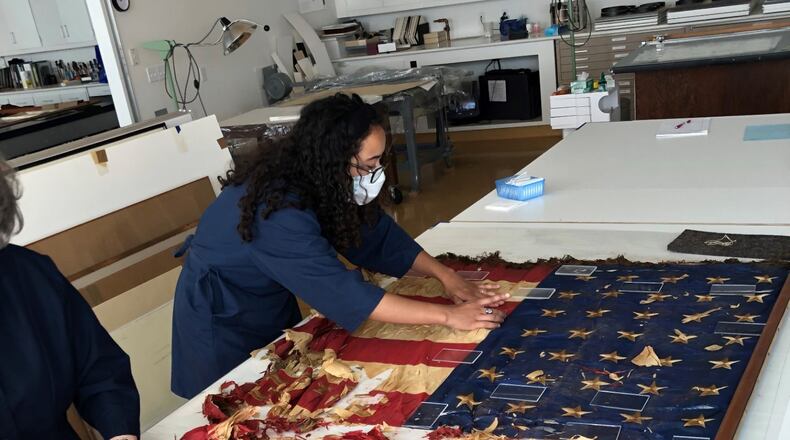But when it arrives, it won’t be the same battle flag the historical society thought Smith delivered last July to Cleveland for restoration.
This ancient silk flag indeed was used by the 35th Regiment of the Ohio Volunteer Infantry, also known as “the Butler Boys” for the county where they assembled. But it wasn’t the flag residents of Cynthiana, Ky. sewed for the 35th regiment. This flag was provided by Lebanon, Ohio.
An observant area historian saw photos the Journal-News published last year of the flag and noticed it had 35 stars — not the 34 that would have been on the flag sewn by those in Cynthiana, Ky., in 1861, while the regiment was headquartered nearby at Camp Frazer. Instead, it had 35 stars, the number U.S. flags had after July 4, 1863, when West Virginia became a state.
But in some cases, a 35th star was added to the existing 34-star flags to account for West Virginia’s addition. So the historical society asked the Intermuseum Conservation Association-Art Conservation to see how many stars originally were placed on the flag. The answer was 35, meaning this flag was the one used later in the war, after the Cynthiana original was retired following the decisive Union victory at Missionary Ridge in November 1863.
The Cynthiana flag was so damaged, the regiment wrapped it around its pole and gave it the nickname “The Old Invalid,” and apparently never have unfurled it again.
“Sometime in December of 1863 or early 1864, the unit was presented a new flag by residents of Lebanon, Ohio,” Smith wrote in an email to William Penn, the editor of the Harrison County (Kentucky) Historical Society.
Penn had been hoping it was the Cynthiana flag because that city is in his county. Instead, the flag being restored was the one the Butler Boys flew during the Battle of Resaca (Georgia, in May 1864), Battle of Kennesaw Mountain (Georgia, June 1864), Peachtree Creek (Georgia, July 1864) and Siege of Atlanta (July and August 1864).
Big-time danger
Soldiers were especially courageous when carrying such flags during battles because commanding officers from a distance used them to identify where various units were deployed. So opposing troops would shoot at those holding the flags, trying to create chaos among the enemy.
When Smith last year drove the flag to Cleveland in his Toyota Highlander, it “was a little tedious and a little anxious” because Jane Hammond, the textile conservator for Intermuseum Conservation Association, told him, “if it’s vibrating a lot, that’ll just continue to deteriorate it to powder — those fibers will break off with every vibration.”
Even after giving that warning, Hammond last year was surprised when it arrived.
“It’s probably one of the more deteriorated flags I’ve ever seen,” she said last year. “I was a little shocked at its condition — nobody knew what to expect.”
Because both flags had gone unseen since the 1860s, it was impossible to know which was which, but society leaders believed it was the Cynthiana flag because a unit history states that after the war, the regiment’s original 1861 flag was given to Ferdinand Vanderveer, the general who organized the unit and later became a Hamilton lawyer and died in 1892. The other flag given to Captain Samuiel L’Hommedieu.
A grandson of Vanderveer, whose mother was the general’s daughter, in the mid-1950s gave the society the flag now being restored, which sat in storage until last year. Before the donation, the flag had traveled with her from Hamilton to Michigan, where the daughter lived with her husband, and later to California.
Butler County’s society now plans to investigate whether anybody knows something about the Lebanon ladies who donated the regiment’s flag. A plate on the pole says it was made by Longley & Brother Flag Manufacturers in Cincinnati. The society also is still looking for descendants of the unit’s soldiers, and already have found some.
Meanwhile, conservators will re-humidify small sections of the flag, which had the consistency of very fragile tissue paper, so more of the silk doesn’t deteriorate into powder, and flatten the sections, before carefully cleaning it. It will be attached to a translucent mesh and mounted in a humidity-controlled frame.
About the Author


